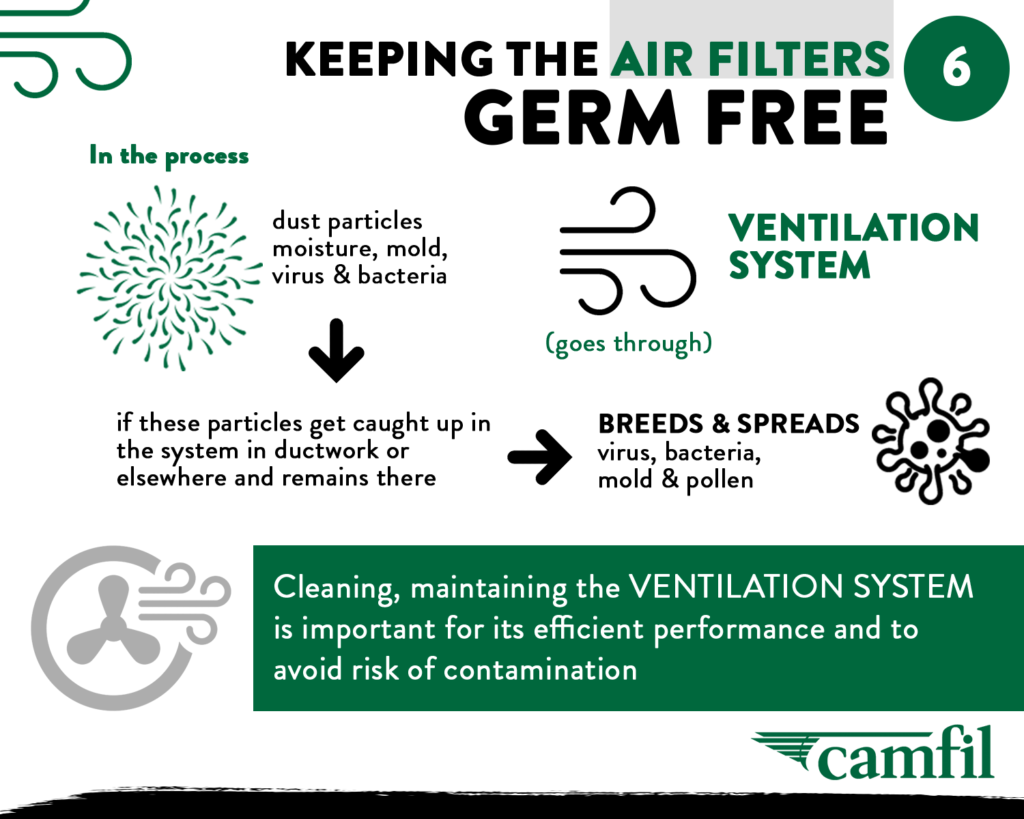Summary:
In this blog post air filtration experts break down the risk of inhaling virus and bacteria particles, review antiviral and antimicrobial filters on the market, and examine the true effectiveness of these filters in capturing and/or neutralizing viruses and bacteria.
What Are Antiviral/Antimicrobial Air Filters?
In light of the COVID-19 pandemic, there has been an increased awareness of virus particles and bacteria that linger in the air indoors and are harmful to human health when inhaled. As such, antiviral and antimicrobial filters have made a resurgence in the air filtration market with various manufacturers offering filtration products that are claimed to be treated with chemicals/biocides. These chemicals are supposed to “kill” pathogens that reach the air filter.
While the implementation of these filters may seem like a sensible solution in mitigating the spread of hazardous particles, there are key concerns that call into question the filters’ true effectiveness. These concerns include, but are not limited to, the potential risk of harmful emissions that enter the airstream as a result of these chemical treatments, efficiency claims that are validated by incomplete lab results, and the probability of decreasing efficiency of the chemical treatments over time.
How Do Virus and Bacteria Particles Spread Indoors?
Before exploring the concerns surrounding antiviral and antimicrobial air filters, it is necessary to establish clear definitions of viruses and microorganisms (specifically bacteria) and their impact on indoor air quality (IAQ).
Viruses are categorized as small parasites that tow the line between living and non-living as they cannot replicate without a host cell. While viruses can be important tools in cell biology research, they typically act as causative agents of many diseases1. Virus transmission can occur through the ejection of infected respiratory droplets (e.g. via coughing or sneezing), by touching surfaces that are contaminated and then touching mucous membranes, and airborne transmission2. While the first two transmission routes can be largely mitigated through social distancing and good hygiene practices, smaller droplets (or aerosols) can remain suspended in the air for long periods and can travel quite far.
Microorganisms, or microbes, are classified as living, and can refer to bacteria, fungi, archaea, or protists3. Microbes are necessary for maintaining the world’s systems and protecting human health. They serve to treat sewage, decompose organic matter, and are vital components of fertile soil. In humans, microorganisms are essential to many components of the body, including the gastrointestinal tract4. However, microorganisms can be bacteria that cause disease and are suspended in the air as bioaerosols5.
Are Antiviral/Antimicrobial Filters Effective in Removing Aerosols and Bioaerosols?
Based on the airborne nature of viruses and bacteria and their effects on IAQ and human health, air filtration manufacturers are attempting to respond to this challenge. Unfortunately, the application of chemically treated antiviral/antimicrobial air filters are not proven to be the correct answer. There are several key concerns involving the use of these air filtration products, including:
Risks of Emissions of Dangerous Chemical Components
The manufacturers creating “chemically treated” filters often do not specify which chemicals are being used. Therefore, there is a risk that chemical components will pass through the air filter and thus contaminate the surrounding air. The Federal Environment Agency (FEA) in Germany also corroborated this in 2005, warning that air filters with biocide or biostatic treatments should not be used at all due to the non-calculable risk of hazardous substances being released into the air stream6.
Antiviral and antimicrobial filters may therefore provide more harm in the form of worsened air quality than the help provided by their hypothetical ability to kill dangerous pathogens.
Independent Institutes Do Not Recommend Using Filters with Chemical Treatment
In addition to the warning from the FEA, the American Society of Heating, Refrigerating and Air-Conditioning Engineers (ASHRAE) also stated that “…the addition of antimicrobial [coating] on filter fibers had little effect on the growth (or lack thereof) of microbial contaminants on the filter.” This conclusion was made upon the completion of a research project conducted by ASHRAE, in which antimicrobial coating was added to filters using three different EPA registered treatments7.
Concerns Involving Testing Protocols and Stable Filtration Efficiency
The efficiency of antimicrobial filters is largely misrepresented. Tests are conducted in a lab, not in a practical application. For instance, tests are completed in liquid, and do not take into account dust loading and airflow. Furthermore, some testing methods are not relevant for air filters.
General Lack of Benefit from Treatment (Antiviral Filters)
This concern specifically applies to antiviral filters. Only viruses (aerosols) that are captured by an air filter can be inactivated, and this inactivation process typically occurs within 48 hours. A newly installed MERV 14/14A filter can allow up to 25% of sub-micron particles to pass through and not make contact with fibers thus remaining active. What is more, a coarse fiber MERV 14 filter can decrease in efficiency throughout its life allowing even more virus particles to pass through. As viruses die off without a host, regardless of chemical treatment, capture efficiency is the most important component of an air filter. Moreover, antiviral substances can only assist in inactivating viruses when they come into direct contact with the filter fibers, therefore chemicals are rendered ineffective once the dust load increases.

What Air Filtration Solutions Can Be Used Instead of Antiviral/Antimicrobial Filters?
There are other, more proven solutions that are highly effective in purifying indoor air. The Hi-Flo ES from our bag filter line has the lowest average pressure drop to ensure the lowest energy cost in the industry, and requires fewer filter changeouts. It can also be used with a prefilter such as the 30/30® Dual 9 to extend the final filter life even further.
For those who are concerned with installing the most efficient filters on the market, we recommend the application of high efficiency particulate air (HEPA) filters. These filters are able to capture at least 99.97% of particles at a size of 0.3 micron. Therefore, they can effectively trap bacteria and viruses as they are found in particles at <1 micron. We suggest the Absolute VG, which has an optimized, compact construction and a high airflow.
There are a variety of factors that determine which air filtration solutions will best protect your facility from bacteria and viruses. Be sure to contact an experienced commercial building air filtration consultant to find the air filtration solutions that are right for your building.
About Camfil Canada Clean Air Solutions
For more than half a century, Camfil has been helping people breathe cleaner air. As a leading manufacturer of premium clean air solutions, we provide commercial and industrial systems for air filtration and air pollution control that improve worker and equipment productivity, minimize energy use, and benefit human health and the environment. We firmly believe that the best solutions for our customers are the best solutions for our planet, too. That’s why every step of the way – from design to delivery and across the product life cycle – we consider the impact of what we do on people and on the world around us. Through a fresh approach to problem-solving, innovative design, precise process control, and a strong customer focus we aim to conserve more, use less and find better ways – so we can all breathe easier.
The Camfil Group is headquartered in Stockholm, Sweden, and has 33 manufacturing sites, six R&D centers, local sales offices in 30 countries, and about 4,800 employees and growing. We proudly serve and support customers in a wide variety of industries and in communities across the world. To discover how Camfil Canada can help you to protect people, processes and the environment, visit us at www.camfil.com/en-ca/.
##
Media Contact:
Holly Gardner
Camfil Canada Inc.
T: 437-929-1161
F: Follow Camfil Canada on Facebook
L: Follow Camfil Canada on LinkedIn
T: Follow Camfil Canada on Twitter
Resources:
2https://www.cdc.gov/infectioncontrol/spread/index.html
5https://www.frontiersin.org/articles/10.3389/fvets.2017.00121/full

